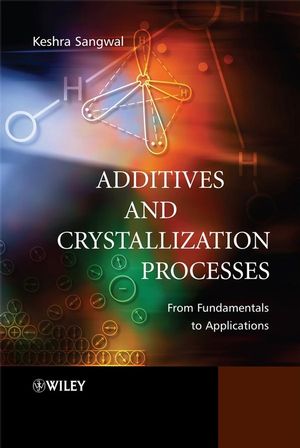Additives and Crystallization Processes: From Fundamentals to Applications

Additives and Crystallization Processes: From Fundamentals to Applications
ISBN:978-0-470-51782-6September 2007468页
Download Product Flyer
Description
本书介绍了添加剂在结晶过程中添加剂,晶体的生长和聚集过程中添加剂作用机制的广义描述,并获得了国际晶体增长组织总裁的认可。它是第一个介绍添加剂在实验室,自然和工业中遇到的不同结晶过程中作用的文本,如药物,食品和生物燃料。
A unique highlight of the book are chapters on the effect of additives on crystal growth processes, since the phenomena discussed is an issue of debate between researchers
Table of contents
Preface xiii
1Complexes in Solutions 1
1。1Structure of Common Solvents 2
1。2 Structure of Pure Aqueous Electrolyte Solutions 4
1.2.1溶液中电解质离子的溶剂化4
1.2.2浓缩和饱和电解质溶液6
1.2.3 Aquo和部分Aquo复合物的形成8
1.3含有添加剂的水溶液溶液的结构10
1。4 Polyelectrolytes and Surfactants in Solutions 16
1。5 Polydentate Ligands and Molecular Additives 18
1.6晶体添加相互作用19
References 19
2 Three-Dimensional Nucleation and Metastable Zone Width 21
2.1相变的驱动力22
2.2晶体的三维成核25
2.2.1三维成核率25
2.2.2三维异质成核30
2.3 Metastable Zone Width 35
2.4亚稳态的成核和转化38
2.4.1 Crystallization of Metastable Phases 38
2.4.2 Overall Crystallization 41
2.5结晶的诱导周期47
2.6 Effects of Additives 52
2.6.1 Solubility 52
2.6.2 Three-Dimensional Nucleation Rate 56
2.6.3 Metastable Zone Width 56
参考文献62
3 Kinetics and Mechanism of Crystal Growth: An Overview 65
3.1 Crystal Growth as a Kinetic Process 66
3.2 Types of Crystal–Medium Interfaces 67
3.3 Roughening of Steps and Surfaces 69
3.3.1热力学粗糙和表面熵因子70
3.3.2动力学粗糙72
3.4 Growth Kinetics of Rough Faces 73
3.5完美光滑面孔的增长动力学75
3.6不完美平滑面的生长动力学78
3.6.1 Surface Diffusion and Direct Integration Models 78
3.6.2 Bulk Diffusion Models 80
3.6.3 Growth by a Group of Cooperating Screw Dislocations 82
3.6.4 Preferential Growth at Edge Dislocations 84
3.7 Effect of Foreign Substances on Growth Kinetics 85
3.7.1一些一般考虑87
3.7.2 Growth Kinetics by Heterogeneous Two-Dimensional Nucleation 90
3.8实际晶体生长机制96
3.8.1 Structure of Interfacial Layer 96
3.8.2 Sources of Growth Steps 100
3.9 Techniques for Studying Growth Kinetics 104
References 105
4杂质对晶体生长动力学的影响109
4.1移动和固定杂质109
4.2 Surface Coverage and Adsorption Isotherms 112
4.2.1 Adsorption Isotherms 113
4.2.2通过吸附杂质的表面自由能的变化115
4.3 Kinetic Models of Impurity Adsorption 115
4.3.1 Earlier Models 115
4.3.2 Velocity of Curved Steps 116
4.3.3在扭结中的杂质吸附在步骤中:Kubota – Mullin型号118
4.3.4地面露台上的杂质吸附:Cabrera – Vermilyea模型119
4.3.5 Effectiveness Factor for Impurity Adsorption 121
4.3.6 Adsorption of Two Competing Impurities 124
4.4 Confrontation of Impurity Adsorption Mechanisms with Experimental Data 127
4.5 Time-Dependent Impurity Adsorption 132
4.6在存在杂质的情况下生长动力学136
4.6.1基本动力学方程136
4.6.2 Time Dependence of Face Displacement 141
4.6.3动力学系数对步进运动对杂质浓度的依赖性142
4.7 KDP型晶体143
4.8 Growth-Promoting Effects of Impurities 146
4.8.1 Decrease in Step Free Energy and Roughening of Steps 147
4.8.2 Formation of Surface Macroclusters 152
4.9 Impurity Adsorption on Rough Faces 157
4.10 Formation of Two-Dimensional Adsorption Layer 158
4.11添加剂与晶体接口160之间的相互作用
4.11.1 Nature of Impurity–Crystal Interactions 160
4.11.2 Chemical Aspects of Impurity–Crystal Interactions 166
4.12量身定制的添加剂172
References 174
5 Dead Supersaturation Zone and Threshold Supersaturations for Growth 177
5.1增长阈值过饱和的起源179
5.1.1 Basic Kinetic Equations 179
5.1.2 Three Different Distances Between Impurity Particles 182
5.2确定V(σ)和R(σ)数据184的阈值过饱和度
5.2.1涉及合作螺旋的模型与幂律方法之间的关系185
5.2.2幂律方法与经验表达与校正过饱和的经验表达185
5.2.3 Determination of σ∗ 186
5.3阈值过饱和对杂质浓度的依赖性:基本理论方程和线性近似187
5.4 Confrontation of Theoretical Equations with Experimental Data 190
5.4.1 Impurity Adsorption at Kinks and Surface Terrace 190
5.4.2阈值过饱和和杂质吸附等温线193
5.5 Impurity Adsorption and Solution Supersaturation 197
5.6比率σd/σ∗和σ∗/σ∗ *的依赖性在CI 198上
参考文献202
6 Mineralization in Natural and Artificial Systems 205
6.1 Biomineralization as a Process 205
6.1.1 Structure and Composition of Biominerals 205
6.1.2 Humans and Animals 206
6.1.3 Plants 209
6.1.4软体动物壳和禽蛋壳211
6.2病理矿化216
6.3 Effect of Biologically Active Additives on Crystallization Processes 222
6.3.1总降水动力学222
6.3.2总体增长动力学230
6.3.3 Phases and Polymorphs of Crystallizing Calcium Salts 242
6.3.4亚稳态阶段的转换247
6.4 Scale Formation and Salt Weathering 258
References 262
7 Morphology and Size Distribution of Crystals 265
7.1 Growth Morphology of Crystals 266
7.1.1 General Concepts 266
7.1.2 Effect of Additives on Surface Morphology 273
7.1.3 Effect of Solvent on Crystal Morphology 275
7.1.4生长形态276
7.2 Ostwald Ripening and Crystal Size Dispersion 282
7.3晶体尺寸分布284
7.3.1人口平衡方法285
7.3.2平衡成核增长方法289
7.3.3 Approach Based on Law of Proportionate Effect 291
7.3.4 Effect of Additives on Crystal Size Distribution 295
7.4 Control of Shape and Size of Particles 298
7.4.1生长指导的合成298
7.4.2 Template-Directed Synthesis 307
7.5 Biological Tissue Engineering 311
参考文献314
8 Additives and Crystallization Processes in Industries 319
8.1制药行业320
8.1.1药物晶体的成核,生长和形态321
8.1.2 Preparation and Size Distribution of Drug Particles 324
8.2 Petroleum Industry 330
8.2.1一些基本概念331
8.2.2 Crystallization Behavior of Linear Long-Chain n-Alkanes 332
8.2.3 Biodiesels and their Crystallization Behavior 338
8.3 Food Industry 348
8.3.1 Some Basic Concepts 351
8.3.2大量食物脂肪的结晶356
8.3.3 Crystallization of Polymorphs 361
8.3.4乳液中脂肪和油的结晶366
8.3.5乳液系统中的成核中心数量和总体结晶372
References 377
9晶体中的杂质掺入381
9.1 Types of Impurity Incorporation and the Segregation Coefficient 382
9.2平衡分离系数386
9.2.1二元混合方法386
9.2.2 Thermodynamic Approach 388
9.2.3理论预测及其与隔离系数的实验数据389的比较
9.3有效隔离系数396
9.3.1 Volume Diffusion Model 396
9.3.2 Diffusional Relaxation Approach 397
9.3.3 Statistical Selection Approach 401
9.3.4表面吸附方法402
9.4有效分离系数与面部生长速率之间的关系410
9.5 Threshold Supersaturation for Trapping of Impurities During Growth 413
9.6 Effective Segregation Coefficient and Internal Stresses Caused by Impurities 416
参考文献418
List of Symbols 421
Subject Index 427
Author Index 437
Reviews
"This book is stimulating for both beginners and experts engaged in crystallization from solution … .[A] very readable and an up-to-date research handbook." (Crystal Research and Technology, September 2008)
